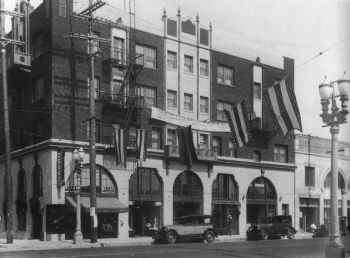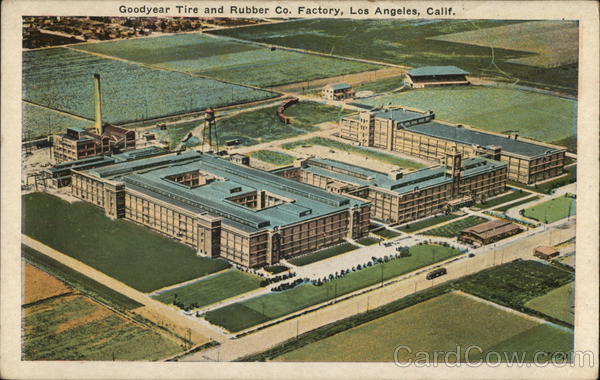 |
| Is this the real life? Or is it fantasy? |
"Wait 'til next year!"
The rallying cry of despair, yet one of seemingly futile hope, was the Dodger fan's mantra come October for many seasons, but most specifically for the past decade and a half. A phrase that seemingly began in the pages of the local Brooklyn newspapers in the 1940s that applied to Dem Bums of Flatbush, a Dodgers team that had boasted seven pennants to its name, yet not one World Series title since the competition began in 1903. A team that had seized the NL Pennant during the War and Post-War years of 1941, 1947, 1949, 1952 and 1953, yet falling short when it came time to face the AL Champions, which, as cruel fate had it, was the form of the Evil New York Yankees Empire - all five times. It was a period of instability, forcing six different managers to go through the wringing machine of frustration. Not even the arrival of great pioneering Pasadena phenom known as Jack Roosevelt Robinson, now canonized throughout MLB, was able to turn the tide of tribulation during those years.
"Wait 'til next year!"
But in 1955, that year finally did come. The great Walter Alston, into his 2nd summer as skipper, led his Boys of Summer, including Robinson, Roy Campanella, Pee Wee Reese, Don Newcombe, Duke Snider, Gil Hodges and some kid named Koufax, to glory.
Those of you who follow The Militant Angeleno on Twitter, or have read This Here Blog since BITD (that's 2007), know that he has talked a whole lot about the Dodgers. They have been a part of his life since 197x, and without expounding on it too much (yeah, this post is gonna be long, brace yourself), Dodgerdom is one of the basic tenets of being an Angeleno. The Militant has, among other things, covered the epic 50th Anniversary Coliseum Exhibition Game, attended Clayton Kershaw's MLB debut, rode his bike to the games, featured the early efforts to get permanent bicycle parking implemented at The Stadium and took a tour of the first set of stadium renovations by Los Guggenheim in 2013.
So, even if The Militant doesn't really blog that much (unless there's an Epic CicLAvia Tour to be revealed), he felt it was important, in light of recent developments, to break out of his quasi blog-retirement and hammer out a post for old times sake. Cool?
The Militant has witnessed three Dodgers World Series Championships in his lifetime. The second was in 1988, the Year of the Improbable. Gibson. Orel. Hatcher. Et al. "She is gone!" Ad infinitum. You all know it by now.
So what has it been like for a Dodger fan to wait 32 years for another Championship?
"Wait 'til next year!"
...We waited in 1989, vaingloriously. Back-To-Back? The Lakers did it in '87 and '88, right? But not even the addition of Eddie Murray and Willie Randolph could get the Boys in Blue past 4th place. And to add insult to injury, our Hated Rivals took the Division and the Pennant...
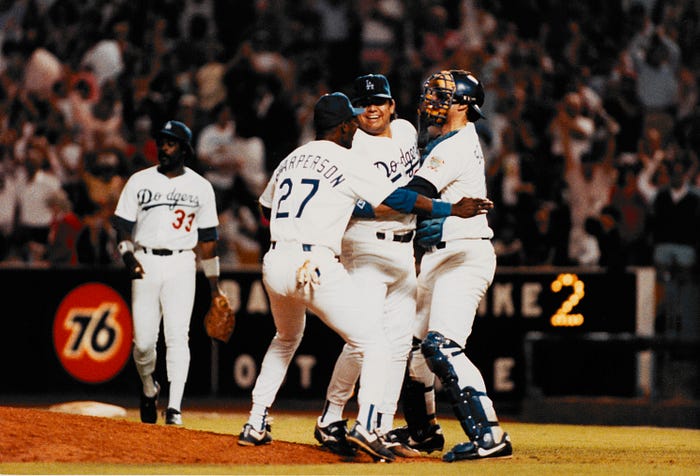 |
| Sombreros to the sky! Fernando's no-hitter on June 29, 1990. |
...We waited in 1990, things got a little better. That Ramon Martinez kid was showing some promise. Fernando Valenzuela threw a no-hitter on June 29. We traded some of our '88 heroes for obscure guys. Second place to the Reds...
...We waited in 1991, we got Mets '86 Champion and Crenshaw product Darryl (DAAAAA-RUUULLL) Strawberry in Dodger Blue. 28 Homers and 99 RBIs, but aside from that, it got...a bit...complicated. Second place to the Braves (an NL West team back then, by virtue of their Milwaukee years)...
...We waited in 1992. The city burned down and so did the team's hopes. Despite Kevin Gross' no-hitter on August 17 and the emergence of a young first baseman named Eric Karros, who won Rookie of the Year, it was a season to forget. A 63-99 record. Last place (in a 7-team division then). Their worst year in Los Angeles. Ugghhh...
/cdn.vox-cdn.com/assets/721556/mike-piazza-1993.jpg) |
| Piazza Man: He delivers. |
...We waited in 1993. The Dodgers changed their broadcast channel from KTTV 11 to KTLA 5. The season got better - how could it get any worse? A rookie catcher and Lasorda family friend named Mike Piazza gave us 35 HRs, 112 RBIs and a ROY award. Still, it was the most mediocre season ever - 4th place, 81-81, a .500 year...
...We waited in 1994. A couple NL n00b teams in Colorado and Florida changed the division maps, and the NL West became a strictly California-Colorado affair of 4 teams. A rookie outfielder named Raoul (RAOOOOOOOOOUULLL) Mondesi hit .306 and stole 11 bases. And he won ROY (Do we detect a theme?). Even though the Doyers finally finished the season in 1st place, WTNY was a mantra for every team in the MLB, as the great Players' Strike shut the season down in August and cancelled the World Series for the first time in 90 years...
 |
| Wondering who was our ace in the mid '90s? Say Nomo. |
...We waited in 1995. GM Fred Claire got us some arms from across the Pacific. A tornado by the name of Hideo Nomo caused damage at home plates across the NL and got him the start at the All-Star Game and the organization's 4th consecutive ROY award. Nomomania had arrived. The Dodgers also placed 1st in the NL West and entered the postseason for the first time since '88...but were swept by the NL Central Champion Cincinnati Reds...
...We waited in 1996. The Los Angeles sports landscape was radically changed that year. Both the Rams and Raiders had left town, the Lakers took a backseat to Michael Jordan's Bulls (but signed Shaq and a high school student from Philly named Kobe Bryant) and the nascent MLS gave us the Galaxy. The heart of the Dodger organization, Tommy Lasorda, suffered a malady with his own heart and retired after 20 years, passing on the Skipper torch to world champion shortstop Bill Russell. Nomo notched a no-no on September 17. The hot bat and baserunning of rookie OF Todd Hollandsworth garnered an unprecedented (coun 'em!) fifth consecutive ROY honor for the team. The Dodgers were edged by the Padres, losing the NL West title by one game, but made the playoffs for the first time as the NL Wild Card team...only to fall to the Braves in the NLCS...
...We waited in 1997. Piazza, Karros, Mondesi and Todd Zeile went yard all season long, but the Boys in Blue placed 2nd in the West, losing the division to the Hated Giants...
...We waited in 1998. The O'Malleys sold the Dodgers to Fox (a.k.a. The Worst Dodger Owner Ever). Russell and Claire were ousted, and Glenn Hoffman became the new skipper, with Tommy Lasorda stepping into a front-office role as GM. Team favorites Piazza, Zeile and Nomo were traded away for a bunch of players relegated to Dodger obscurity. A really young farm-grown third baseman from the DR named Adrian Beltre made his debut. The team placed third in the NL West, now it its current form of 5 teams due to the addition of the D-Backs. The Milwaukee Brewers flipped over to the National League, while the AL expanded to one more team, the Tampa Bay Devil Rays...
:format(jpeg)/cdn.vox-cdn.com/uploads/chorus_image/image/52262067/72358199.0.jpeg) |
| What can Brown do for you? |
...We waited in 1999. The "Los Angeles" script road uniforms, possibly the only positive contribution by the ownership during the Fox Regime, made a comeback after a 30-year absence. Another shakeup was in place with Kevin Malone stepping in as the new GM and veteran MLB manager Davey Johnson as the new skipper. They spent a ginormous amount of money (at the time) on a dude named Kevin Brown, who pitched an 18-9 record with a 3.00 ERA. But all we got was another mediocre 3rd place finish...
...We waited in 2000. It's a new century, so it's gotta be good, right? Brown led the NL in ERA, and Gary Sheffield and Eric Karros lobbed bombs. Dave Hansen and new acquisition Shawn Green also were offensive producers, but the Dodgers placed a distant 2nd place to the Hated Giants. The Lakers were able to win their first title since '88...
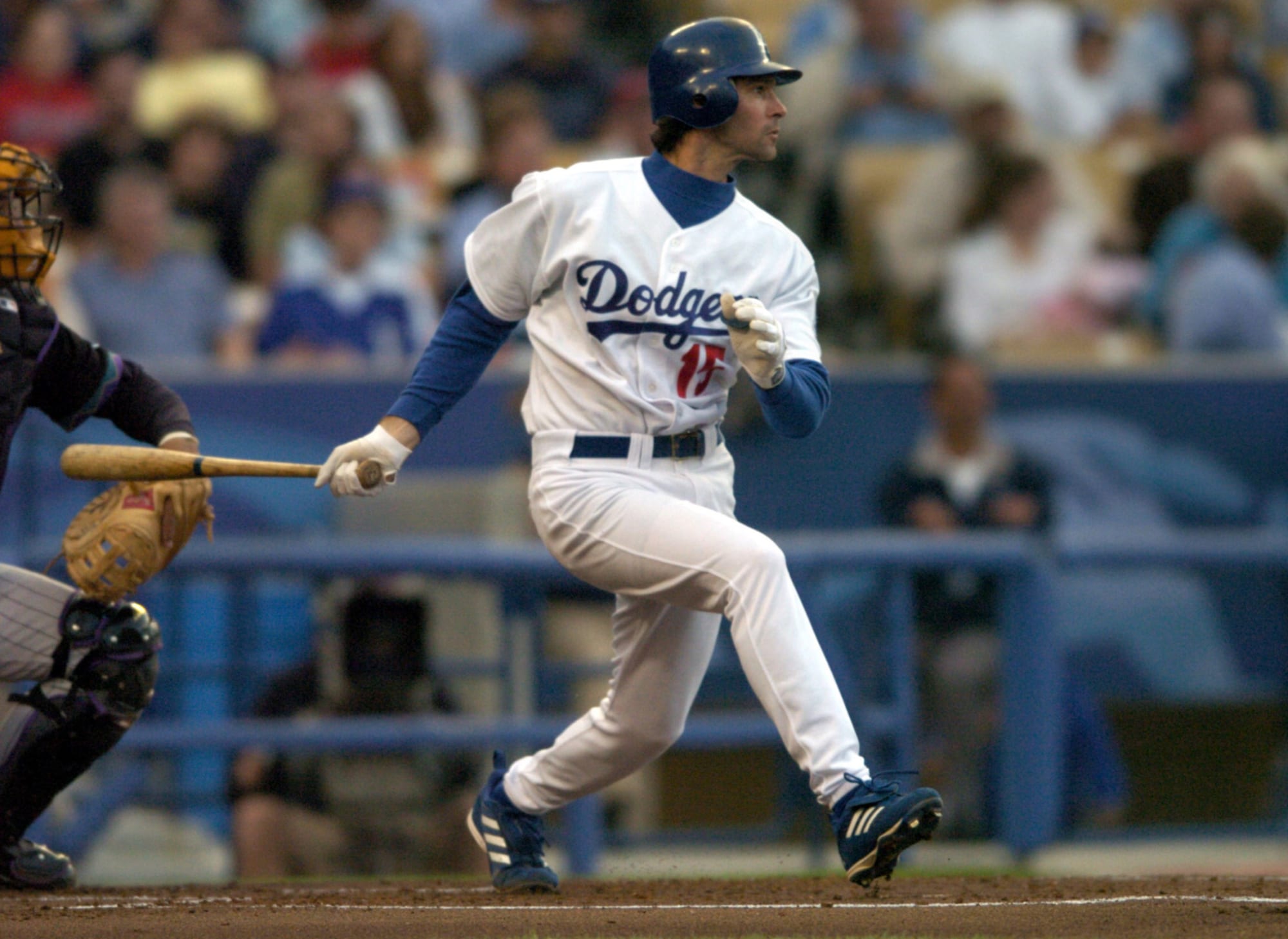 |
| Blue was all about Brown and Green in 2001. |
...We waited in 2001...Johnson was fired and Jim Tracy took over the managing helm. Shawn Green was hot at the plate with a franchise record 49 HRs. Catcher Paul LoDuca was also an offensive force. But the Kevin Brown Project was starting to break down with injuries and not-so quality starts. Orel Hershiser made his 2nd tour of duty in Blue, only to be released before the middle of the season. 9/11 paused the nation, and the MLB season, for nearly a week. The Lakers went Back-To-Back. Dodgers? They just got set back - a 3rd place finish to the year...
...We waited in 2002...The games were now broadcast on KCOP 13, Dan Evans became GM. Green continued to be hot, and a starter-turned reliever named Eric Gagné notched a team record 52 saves. Game Over. Nomo returned to Los Angeles for his 2nd tour of duty. A newly-acquired OF named Dave Roberts also made his Dodger debut this season. The Lakers went Back-To-Back-To-Back. The Dodgers got a Back-To-Back 3rd place finish. The Angels won the All-Wild Card World Series. But, coached by 1988 WS Dodger heroes, at least they beat the Hated Giants.
...We waited in 2003...Green and LoDuca were still hot at the plate, and Gagne was so hot, he won the Cy Young. And yet, a distant 2nd place finish...
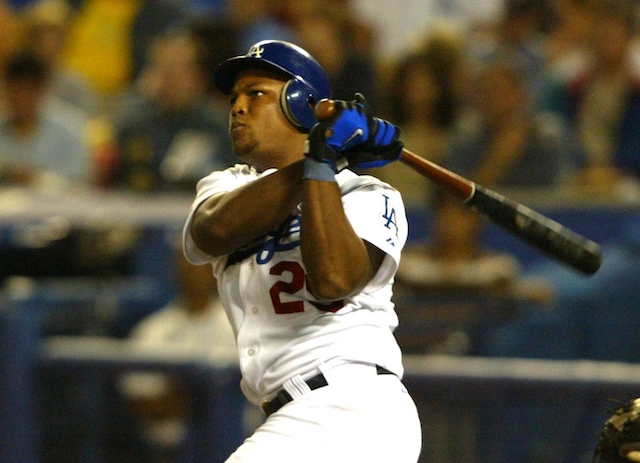 |
| Beltre belted in 2004. |
...We waited in 2004...Another ownership change. Fox, the only Dodger owner to never win a game in the Postseason, sold the team to Boston parking lot developer Frank McCourt, who promptly brought in Paul "Pre-pedo Jared from Subway" DePodesta as GM, introducing this weird exotic concept called sabermetrics to the organization. Adrian Beltre had a breakout year with a team-leading .334 AVG, and fans chanted "MVP!" during his at-bats. The Dodgers win the NL West and got their first postseason win since 1988 thanks to starter Jose Lima's stellar NLDS shutout of the Cardinals. But the Dodgers were eliminated in 4 games. DePodesta also traded away Roberts to the eventual World Champion Red Sox, where he played a key role in their title run...
...We waited in 2005...After a phenomenal 14-2 start to the season, it quickly crashed the rest of the way. Early-season hero Milton Bradley became a clubhouse cancer by the second half, and injuries and mediocrity galore plagued the season, ending in a pathetic 71-91 4th place finish. The Montreal Expos immigrated south to Washington D.C. to become the Nationals. It's now been 17 years since the last Championship; the previous title drought was the 16 years between '65 and '81. What's going on here...
 |
| Nomar capped off an unbelievable rally on September 18, 2006. |
...We waited in 2006...McCourt cleaned house and hired Cubs/Giants front office veteran Ned Colletti and Red Sox World Champion manager Grady "Forrest Gump" Little. Whittier native Nomar Garciaparra got to return to both his hometown and his old manager, and trading Bradley for an A's prospect named Andre Ethier started to pay dividends. The farm system also produced a promising harvest in the form of OF Matt Kemp and catcher Russell Martin. On September 18, the team hit back-to-back-to-back-to-back HRs to tie the Padres in the late innings, and won by a Nomah walkoff in extras. Little's postseason experience did get the Dodgers a Wild Card appearance in the playoffs, only to be swept by the Mets in the NLDS. Now 18 years without a title...
...We waited in 2007...Colletti signed Jason Schmidt and Randy Wolf to the rotation, and homegrown rookies Martin, Kemp and James Loney took the team to the top in the first half, but ended the season in fourth. Nineteen years without a title...
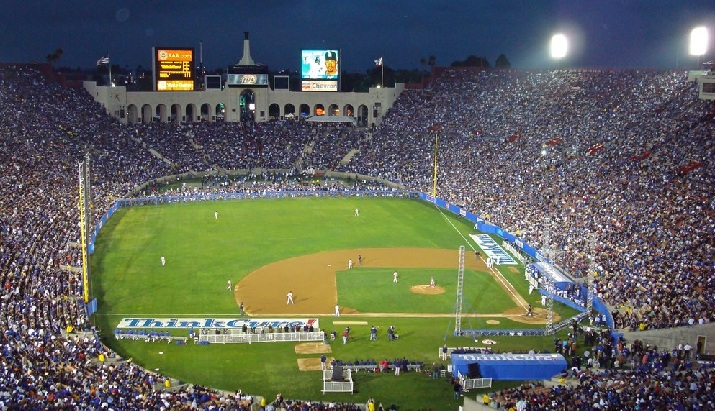 |
| Dodger baseball back in the Coliseum, 3/29/08! |
...We waited in 2008...Happy 50th Anniversary in Los Angeles! Grady was of Little help. In came Joe Torre, an Italian American manager with 4 titles in his resume. We seem to do well with Italian American managers, right? For the first time since 1961, the Dodgers played a game at the Los Angeles Memorial Coliseum in a one-off exhibition game against Frank McCourt's favorite team, the Boston Red Sox. Though the Dodgers lost the preseason match, the event gathered a world's record 115,300 in attendance - the largest for a baseball game (The Militant was there...). In May, a young rookie named Clayton Kershaw made his major league debut. Colletti worked All-Stars and ring-holders Manny Ramirez and Greg Maddux into the roster. Torre took us to the top of the NL West! Then we swept the Cubs in the NLDS! The Dodgers were finally in the NLCS fir the first time since nan-teen-ety-et. COULD THIS BE THE YEAR? Nope. Dodgers lost the NLCS to the eventual World Champs, the Phillies 4-1. It was an emotional end of the season getting eliminated at home. Nomar did not want to take off his jersey, despite it being the last time he would wear it. Twenty years without a title...
...We waited in 2009. McCourt dumped Vero Beach for Saddleback Ranch in Glendale, AZ. Orlando Hudson hit for the cycle on Opening Day (The Militant was there!) and Manny got suspended 50 games for PEDs. The season was a near copy of the last, winning the West, sweeping the NLDS (against the Cardinals this time) and losing the NLCS to the Phillies, 4-1. Only this time, the NLDS began with a kicker: Frank McCourt and his wife Jaime were separating. This was the beginning of the end of the McCourt Empire. Twenty-one years without a title...
 |
| Clayton Kershaw. There's something about this kid... |
...We waited in 2010. The McCourt Divorce was getting messy. Weird-ass Russian psychics and all that. What was formerly a personal matter was now adversely affecting the organization. But this Kershaw guy was starting to look good. A rookie reliever named Kenley Jansen made his debut. The Dodgers were tired of Manny being Manny and made a whole bunch of trades for obscure dudes. Fourth place finish. To add insult to injury, The Hated Giants won their first Championship in Frisco. For the Dodgers, 22 years without a title...
...We waited in 2011. Dark days in ownership. The McCourt Mess had gotten so messy, the MLB wanted to take over the day-to-day operations. McCourt filed the team for bankruptcy. The same fans who cheered "Frank! Mc! Court!" during the '04 Postseason were now calling for his ouster and to sell the team. It got ugly. Torre decided to jump off the sinking ship by retiring and passed the lightsaber to his Jedi padawan, former Yankees All-Star Don Mattingly. The Dodgers took on an ingredient of the Giants' title success by signing their star infielder Juan Uribe, but it went off on a rough start. Clayton Kershaw won the Cy Young Award, but the team finished 3rd. Twenty-three years without a title...
 |
| Enter Los Guggenheim. |
...We waited in 2012. McCourt relented and finally sold the team. It literally took some Magic. The Lakers legend-turned-businessman who wore #32 (an auspicious number, as we will discover) teamed up with a bunch of rich white dudes to form Guggenheim Baseball Management and become the new owners of the Dodgers for the nice price of $2 Billion With A B. "We are going to bring a championship back to Los Angeles," they said. Yeah. We've heard it before. A few big names were signed/traded in the middle of Los Guggenheim's first year, including Shane Victorino, Hanley Ramirez and the epic trade for two pairs of Red Sox - Josh Beckett, Carl Crawford, Adrian Gonzalez and Nick Punto. Lo, the team placed 2nd and The Hated Giants won their 2nd Championship in SF. The Kings won their first Stanley Cup! The Dodgers? 24 years without a title...
...We waited in 2013. The first full year under Los Guggenheim looked promising; Again the FO tried to nick the good vibrations of the Giants' 2012 title by signing their reliever Brian Wilson. Clayton Kershaw not only pitched a shutout on Opening Day, but hit his first HR (The Militant was there!). Kersh eventually won his 2nd CyYoung. The Dodgers added Zack Geinke and lefty South Korean rookie phenom Hyun-Jin Ryu to their rotation. A rookie OF from Cuba named Yasiel Puig also made his debut. The season had its ups and downs, but ultimately ended by winning the NL West (The first in a series...). They went on to win the NLDS, besting the Braves 3-1. The Dodgers made their 3rd trip to the NLCS in 6 years, ultimately losing to the Cardinals 4-2 due in large part to Hanley Ramirez's injury and a tired team. Former NL West rivals the Houston Astros flipped over to the American League. Twenty-five years and my life is still, tryin' to get up that great big hill of hope, for a destination...
...I SAID HEY YEA...oh sorry, got carried away there. Wow. That's a quarter century. Time to take a deep breath. Or a bathroom break. Sheesh. Now where are we...
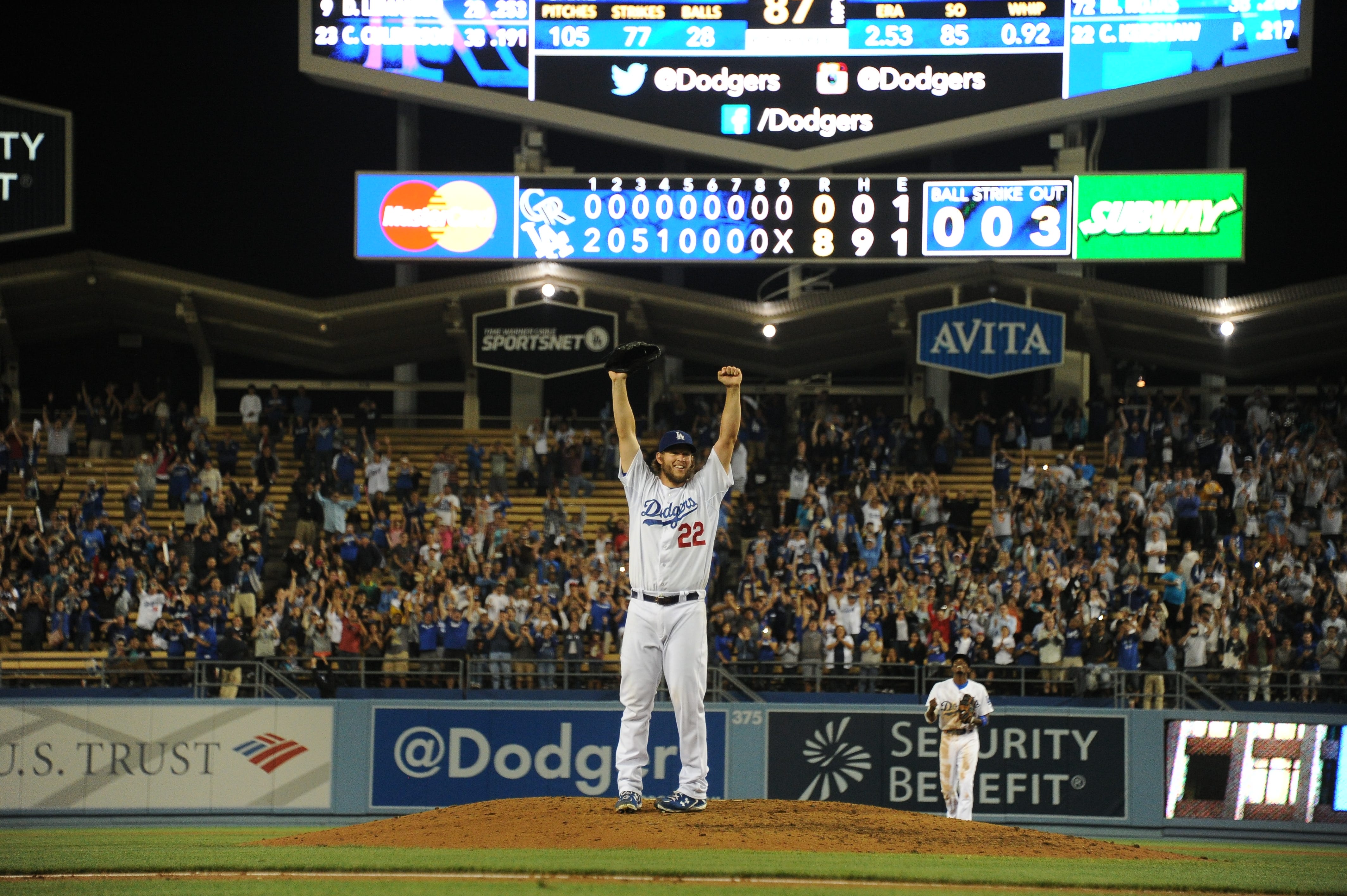 |
| He did it! Kershaw's no-hitter, 6/18/2014. |
...We waited in 2014. Los Guggenheim took the games off free local TV forever by inaugurating the Sportsnet LA cable TV network...which was only available exclusively to Time-Warner Cable (now known as Spectrum) subscribers. A-Gon was hot with the RBIs, Dee Gordon was hot with the baserunning, and Josh Beckett got a no-hitter on May 25. Kersh got his own no-hitter on June 18, and later, his 3rd Cy Young, and his first NL MVP Award. A former mediocre Mets infielder who grew up in Lakewood named Justin Turner became a regular 3rd baseman later in the season. A rookie named Joc Pederson made his debut. The Dodgers won the NL West again, but lost to those f'in Cardinals 3-1 in the NLDS. Despite his season success, in the playoffs, Kershaw was not lights out. Argh! The Hated Giants...well you know. The Kings won their 2nd Stanley Cup! The Doyers? 26 years without a title...
...We waited in 2015. Longtime GM Colletti transitioned out of the GM role and was replaced by Farhan Zaidi, with former Tampa Bay Rays executive Andrew Friedman as his boss. And whoa, they made some moves. They traded a quartet of players, including fan favorite leadoff man Dee Gordon to the Marlins for another quartet, which included utility player Kiké Hernandez and catcher Austin Barnes. Longtime Dodger and Rihanna's ex Matt Kemp was part of a trade deal with the Padres that brought Yasmani Grandal behind the plate. They also brought in Phillies veteran, Long Beach boy and UCLA Bruin Chase Utley back west, and a rookie infielder named Corey Seager made his debut. The Dodgers went on an NL West three-peat - the first in franchise history - but lost to the eventual NL Champs, the New York Mets in the NLDS, 4-1. Twenty-seven years without a title...
...We waited in 2016. Things changed; The Rams and Chargers brought the gridiron back to Los Angeles, and Kobe Bryant called it a career. Mattingly and the organization made a conscious uncoupling, and the search was on for a new manager, ultimately found in Padres coach, UCLA Bruin and former Dodgers outfielder Dave Roberts. The Friedman Machine signed pitcher Kenta Maeda from Japan, and traded prospect Zach Lee to the Mariners for some unknown dude named Chris Taylor. A rookie pitcher named Ross Stripling came real close to throwing a no-hitter in his MLB debut, and a rookie pitcher from Mexico named Julio Urias made his entrance. Reliever Kenley Jansen was named NL Reliever of the Year and made the All-Star team. The great Vincent Edward Scully announced his retirement after 67 glorious seasons at the mic and called it a career at the end of the regular season. For the fourth year in a row, the Dodgers won the NL West, and beat the Nationals in the NLDS 4-1. They went on to the NLCS, but lost to the eventual World Champions, the Chicago Cubs, themselves ending a 108-year championship drought. Twenty-eight years without a title (But it could be worse?)...
 |
| Cody. |
...We waited in 2017. Unfinished business as usual. A rookie from the farm named Cody Bellinger was played OF and took over for an injured A-Gon at 1B. And boy did he take over, leading the team in HRs and eventually winning NL Rookie of the Year. Formerly-mediocre acquisistions like Turner, Taylor and Hernandez were turning into solid players both at the plate and on the field. The Dodgers won the NL West for the 5th year in a row winning 104 games, and swept the D-Backs in the NLDS and finally got over the NLCS hurdle by besting the defending champion Cubs 4-1, winning their first NL Pennant since '88. The Dodgers were finally going back to the World Series! They faced an evenly-matched Houston Astros in a much-heralded playoff smackdown but lost in Game 7 due to lackluster hitting and the implosion of midseason trade acquisition pitcher Yu Darvish - Or so we thought at the time. Twenty-nine years without a title...
/cdn.vox-cdn.com/uploads/chorus_image/image/61930503/1054089390.jpg.0.jpg) |
| Late Night with Max Muncy, 2018 World Series Game 3. |
...We waited in 2018. Matt Kemp made a return engagement. Corey Seager ended his season early due to injury. Justin Turner spent a good amount of time on the Injured List, and some unknown guy named Max Muncy filled in at 3B, only to lead the team in HRs. Rookie Walker Buehler played in his first full season and made a huge impression. They acquired Orioles infielder Manny Machado at the trade deadline. Winning a 163rd regular season game against the Rockies as the division tiebreaker, the Dodgers captured the NL West title for the sixth straight year. They beat the Atlanta Braves 3-1 in the NLDS and edged the Mlwaukee Brewers in 7 games in the NLCS to win their 2nd consecutive NL Pennant (the first back-to-back pennants since '77-'78). But despite winning the longest World Series game in history clocking 7:20 with an 18th-inning walkoff HR by none other than season hero Max Muncy, they were outmatched by a heavily-armed Boston Red Sox in the Fall Classic, losing 4 games to 1. Thirty years without a title...
 |
| The agony. |
...We waited in 2019. Puig and Kemp made their exits, but Russell Martin made a return. Diamonbacks star OF A.J. Pollock was signed, as well as BoSox reliever Joe Kelly (who killed the Dodgers in the 2013 and 2018 postseasons). Cody Bellinger went on a tear and won the NL MVP Award. The other hitters weren't bad either. The Dodgers set a franchise record with 106 wins, winning the NL West for the 7th season in a row. They were hungry for that title, and had all the right ingredients. But the wheels fell off in the NLDS and the team was eliminated by the red-hot Wild Card Washington Nationals in a heart-wrenching Game 5. Kershaw jerseys were mutilated. Thirty one years without a title...
...And we learned the Astros cheated the Dodgers out of a title in 2017?
[cue sad soundtrack music]
And then 2020 came.
The tragic loss of Kobe Bryant.
The COVID-19 pandemic.
The world, the nation, the city -- all on pause.
It wasn't time for Dodger Baseball.
[cue gradually uplifting music]
And then the abbreviated, 60-game, fanless, cardboard cutout, piped-in crowd noise, regionally-scheduled season began on July 23.
The Friedman Machine worked out a trade that acquired OF Mookie Betts and pitcher David Price, both Tennessee natives from the same Red Sox team that dashed our title hopes in 2018. The Friedman Machine was supposed to trade away Joc Pederson but it fell through.
 |
| Needs no introduction. |
Fans weren't there, but the cameras captured it: The suspension-inducing Joe Kelly Face. Kiké making funny faces. Mookie stealing bases, stealing away runs and slappin' dat ass on doubles. Reliever Brusdar Graterol passionately praising The Lord Above. A rested, healthy Kershaw playing like the Cy Young Kershaw. It was a blur, but...
The Los Angeles Dodgers won 43 of those 60 games.
The Los Angeles Dodgers won the NL West for the 8th consecutive season.
The Los Angeles Dodgers swept the Brewers in a best-of-3 Wild Card Series.
The Los Angeles Dodgers called the Texas Rangers' Globe Life Park home for the rest of the season.
The Los Angeles Dodgers swept the emerging San Diego Padres in the NLDS.
The Los Angeles Dodgers bested the Atlanta Braves in a 7-game NLCS.
The Los Angeles Dodgers won their third NL Pennant in 4 years.
 |
| Air Mookie. |
The Los Angeles Dodgers beat the AL-best Tampa Bay Rays 4 games to 2 in the 2020 World Series.
Eleven thousand, six hundred and ninety-five days later, at 8:37 p.m.
Pacific Daylight Time on Tuesday, October 27, 2020, the wait was finally
over.
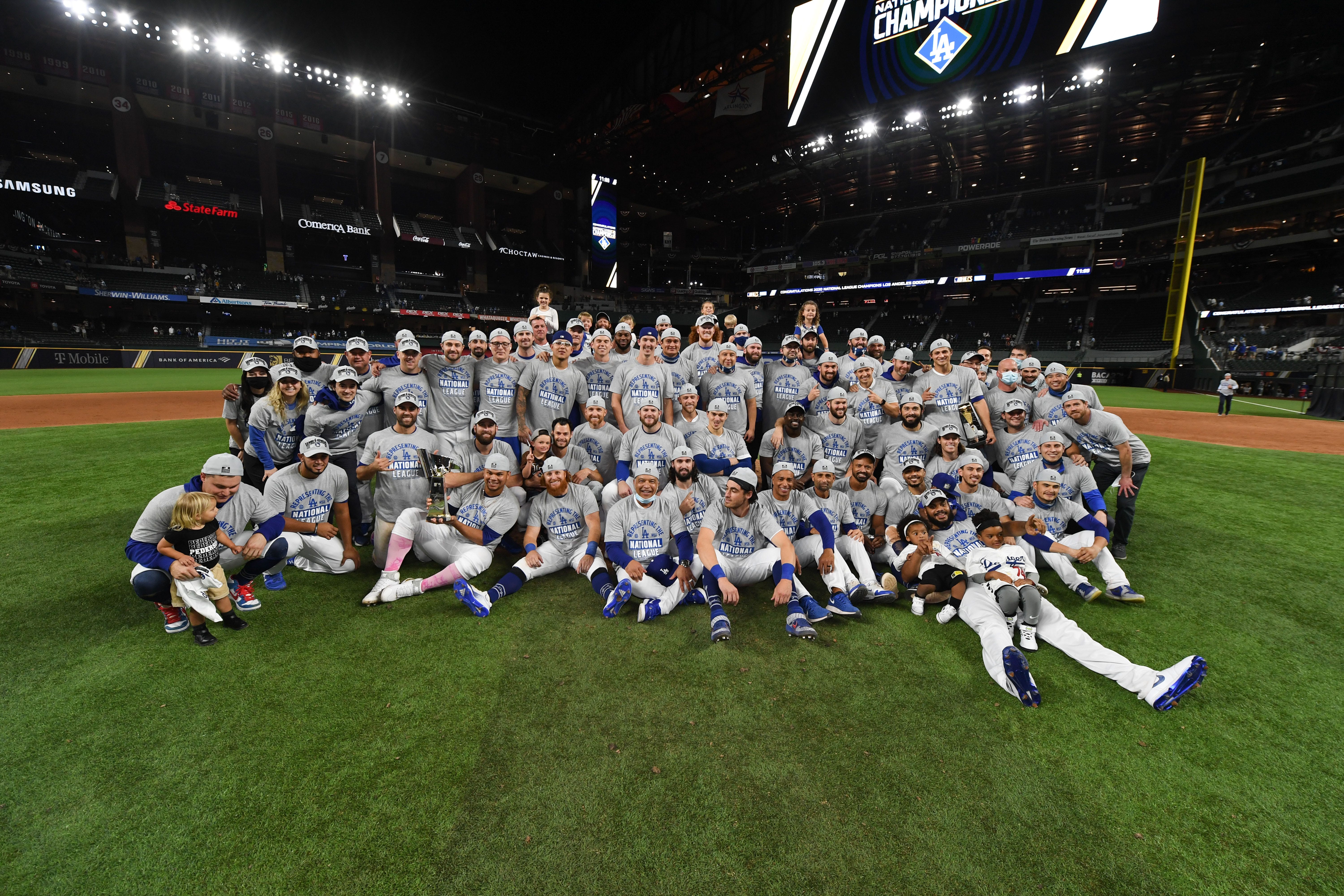 |
| This is our year. |
The Los Angeles Dodgers are World Champions!
THE LOS ANGELES DODGERS ARE WORLD CHAMPIONS!
THE LOS ANGELES DODGERS ARE WORLD CHAMPIONS!
THE LOS ANGELES DODGERS ARE WORLD CHAMPIONS!


.jpg)

